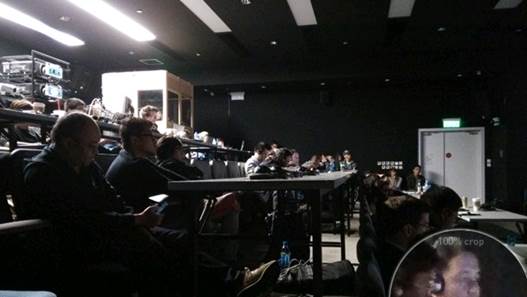Camera
Xiaomi phone says its quad-core phone uses
a 2nd-genaration 8MP BSI sensor, which turned out to be Sony IMX175
(used by a number of Galaxy S III) or Samsung S5K3H7. Our special unit of the
former has the previous, according to the Voodoo Report of Supercurio . Of course, after all, it is the
general optics – 5-element f/2.0 lens – as well as the adjustment of the sensor
software, and we are pleased to inform that Xiaomi Phone 2’s camera does pretty
well in general. The photo above is actually taken in HDR mode, and if the
Xiaomi can be comfortable with the default saturation level for HDR, then it
will be the perfect photo. This problem becomes clearer when we try HDR
photography of Shanghai skyscrapers at night, but you can see it is a
deliberate effect.

A
photo taken by Xiaomi Phone 2
We have some problems with the Xiaomi Phone
2's camera. For example, sometimes we see some major exposure in outdoor photos.
At night, sometimes we see quite a lot of noise in the dark areas (and this is
worse in HDR photos), but at least the details of the lighting theme are
retained, as is shown in the photo below – it shares the impressive low light
performance similar to that of the HTC One X.

It
shares the impressive low light performance similar to that of the HTC One X.
Several readers have asked whether they
will miss a lot if they buy Xiaomi Phone 1S, so we decided to compare the
quality of its camera with the Xiaomi 2’s. With a quick look the Voodoo Report revealed
that the 1S is loaded with the driver for the IMX105 and Samsung S5K3H2 (both
also used by the Galaxy S II, according to what Klug of Anandtech said). Our
special 1S is equipped with Sony sensor, so no wonder the photos it took are
similar to those taken at the same location as long as they are clearly
illuminated with the Xiaomi Phone 2. Note that we say "similar" and
not say "exactly the same" as the new phone creates little-sharper photos,
and it really shows higher sensitivity when we compare these photos taken by
the two devices at night. The Xiaomi Phone 2 achieves 8fps in burst mode (we
had about 15 photos in sequence, with superfine quality settings), while the 1S
does not support burst mode and HDR.
In addition to these performance
differences, the cameras of the two phones provide the same features: panorama
mode, shutter sound (with audio capture), filter effects, white balance,
increase skin tone, red-eye reduction and many other advanced settings. Like
the Optimus G, you can also shoot 1920x1088 photos (yes, it is 1088 for some
reason) while recording 1080p video on the 1S and the 2, but if you have to
shoot full resolution images while recording video, the then you will have to
consider the One X or the Padfone 2.
We do not have many problems about recording
videos on the Xiaomi Phone 2. As you wait, the highest resolution is 1080p, and
we have seen the clip recorded at 25fps and the bit rate of up to 7.3Mbps. It's
less than 10Mbps like on the One X but is still effective. Even on a dark
street at night, the camera retains the same frame rate instead of reducing
frames for exposure compensation – which is the first thing that the Xiaomi
Phone 1 didn’t do well. One error we see in the clip is the somewhat infrequent
random rattle, but potentially it could be resolved through OTA update.

Xiaomi
Phone 2’s camera
In addition to the satisfactory video
camera performance, Xiaomi also adds fast-motion mode (from 2x to 250x) and
slow-motion (60fps or 90fps), and two types of clips that are played back at
30fps pretty smoothly but without sound. Also, there is video stabilization feature,
but it is actually disabled by default, and we got to know the reason soon: the
digital process creates distortion even with the help of the phone's gyroscope.
But for those still-life shots, the anti-vibration system provides many
benefits for some people. Anyway, there are options for you.